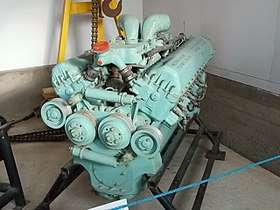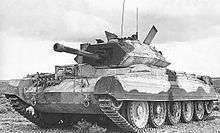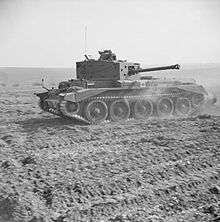Rolls-Royce Meteor
| Rolls-Royce Meteor | |
|---|---|
 Finnish Meteor engine, ex-Comet, in eau de nil, at the Parola Tank Museum | |
| Overview | |
| Manufacturer |
Rolls-Royce Limited Meadows Rover Morris Motors |
| Also called | Rover Meteor |
| Production | 1941–1964 |
| Layout | |
| Configuration | V-12 |
| Displacement | 27.022 litres (1648.96 ci) |
| Cylinder bore | 5.4 inches (140 mm) |
| Piston stroke | 6.0 inches (150 mm) |
| Compression ratio | 6:1–7:1 |
| Combustion | |
| Fuel type | Petrol |
| Cooling system | Water |
| Output | |
| Power output |
550–650 bhp (410–480 kW) Mark IVA: 600 bhp @ 2400 rpm |
| Torque output | 1,450 lb/ft (2,160 kg/m) |
The Rolls-Royce Meteor and later the Rover Meteor was a British tank engine developed in the Second World War. It was used in British tanks up to 1964.
It was developed from the Rolls-Royce Merlin aero-engine by W. A. Robotham and his chassis design and development division at Clan Foundry, Belper, as they were not involved in aero-engine work and his engineers were under-used. With the aid of engineers from Leyland, who were engaged in tank work, he considered RR's two V12s. The Kestrel, while having more power than the existing "Liberty" or Meadows engines, did not provide the desirable 20 bhp per ton required, so the Merlin III was chosen. Robotham was at pains to point out that Rolls-Royce could not manufacture the engines, so would not benefit commercially.
The Directorate of Tank Design (DTD), on 27 April 1941, supported production of the Meteor, eventually placing orders direct with Rolls-Royce to maintain development in connection with the Cromwell tank.[1] A new tank specification, A27M, was produced for design of the Meteor-powered tank. The Meteor engine went on to become one of the most successful British tank engines, changing the way tanks were designed, leading to the Universal tank concept.
Design and development
Engine design
Development started with the use of recovered Merlin engine parts from crashed aircraft. While unsuitable for re-use in aircraft, the Rolls Royce chassis division had begun collecting and refurbishing them in the hopes of finding a use. Robotham was approached by Henry Spurrier of Leyland Mechanization and Aero, to ask about help with tank powerplants. Based on Spurrier's requirement, the first prototype Meteor engine (and subsequent production of Mark 1 engines) was assembled on the basis of recovered Merlin parts.
The major change for tank use was reversing the direction of engine rotation. Automotive gearboxes ran the opposite way to an aircraft propeller and changing direction required modification of the camshaft lobes. The Merlin had its supercharger, reduction gear and other equipment removed from its crankshaft, greatly simplifying its construction. The dimensions were now similar to the Nuffield Liberty engine and it would fit into the Liberty Mark VI version in the Crusader tank.

The first Merlin prepared for tank use was tried in a modified Crusader in September 1941 at Aldershot.[2] The test team had trouble timing its runs because it was so fast, estimating it reached 50 miles per hour (80 km/h). This proved the concept, and the engine was tried in the Crusader tank, surpassing all expectations. The engine was commissioned for use in the new Cromwell tank.
Changes were made to the Cromwell tank development programme to accommodate the new engine. To enable fitting in-line with a Merrit-Brown gear (and steering) box, the engine was lowered. A new flat sump was created, the oil pumps changed and the crankshaft could now line-up with the new gearbox. Many of the aircraft specific parts of the engine were deleted, such as the propeller reduction gear and the aircraft-style starter. The new engine had cast, rather than forged, pistons and was de-rated to around 600 bhp (447 kW), running on lower-octane pool petrol instead of high-octane aviation fuel. British Thomson-Houston (BTH) Magnetos were changed for Simms units.
Expansion into tank design
The engine, and the Rolls-Royce team's fresh look at tank development, had a major impact on British tank design. As development of the engine progressed, the Rolls Royce team became more and more involved in development of the tank. Despite his lack of experience in tank design or warfare, Robotham was made Chief Engineer of Tank Design and joined the Tank Board. He was involved in the Cruiser Mk VIII Challenger tank. The Rolls Royce chassis division, which had commenced the Meteor design, evolved into its Tank Division at Belper and was involved with the overall design of four versions of the Cromwell tank, using a standard set of components.
Production

Early prototypes were produced by Rolls Royce. In 1941, Leyland, which had an order for 1,200 Meteor engines, was still advocating its own diesel tank engine for the Cromwell tank. It would deliver only 350 hp (260 kW), but it was concerned with the problem of sufficient cooling for the Meteor within the confines of the tank engine bay. When Leyland withdrew its support, Robotham took the problem to Ernest Hives. Hives took the problem to the Ministry of Supply, telling Lord Beaverbrook that he already had his hands full making Merlin aero engines, and Rolls-Royce would want £1 million to its credit and 'no interference' to make tank engines, Beaverbrook telegrammed back,
OHMS Ministry of Supply to W. Hives Nightingale Road Rolls-Royce Derby
The British Government has given you an open credit of one million pounds. This is a certificate of character and reputation without precedent or equal. Beaverbrook[3]
An order for 1,000 engines followed, and a new tank design specification was created: A27M, splitting design of the Meteor powered Cromwell away from Leyland to Birmingham Railway Carriage and Wagon Company (BRC&W) resolved the cooling problems, ultimately delivering before Leyland's version, although production leadership later switched back to Leyland when BRC&W could not keep up with demand.
The Meteor was initially produced by Rolls-Royce but manufacturing capacity was severely limited due to the demand for Merlin engines. Early units were still manufactured using recovered Merlin parts and many early Meteors still showed crash damage. When engine manufacturing needed to increase output, brand new engines had to be made. Because weight saving was not so important for a tank engine, some of the Merlin's more expensive light-alloy components were replaced with cheaper, steel versions. It was also envisaged that the Meteor would use some components rejected on quality grounds for the Merlin, i.e. Merlin scrap.[4] Many of these rejected parts while not meeting strict standards for airworthiness, were perfectly adequate for use in ground vehicles where the crew or operators were not subject to the inherent hazards involved in flight.
To increase production, Meadows produced some Meteors but the small factory of 2,000 men was producing 40 types of engine. To make enough Meteors for the Cromwell build programme, Rolls-Royce agreed to move Meteor production to the Rover Company at Tyseley and Morris at Coventry.
Rolls-Royce was also aiding the development of production jet engines at Rover, but progress there was slow and Rover became disillusioned. Hives struck a deal in December 1942 with Spencer Wilks of Rover to trade W.2B/23 production at Barnoldswick for the Rolls-Royce tank engine factory in Nottingham and production of the Meteor, to become officially effective on 1 April 1943. In 1943, an acute shortage of blocks was met by dismantling surplus older marks of Merlin.
Rover took over the Meteor in January 1944 and in 1946 the British Government made Rover responsible for research and development of large military engines. In this role, Rover continued the development and production of the Meteor Mk IVb and various derivatives, including the Meteorite V8 and the M120 V12. Rover ceased this activity in 1964, having produced approximately 9,000 engines and Rolls-Royce again became responsible for the manufacture of spare parts. Future engines for British tanks were manufactured by the engine division Rolls-Royce Diesels of Shrewsbury, which was acquired by Perkins UK in the 1980s. Perkins was taken over by Caterpillar Inc of the USA in 1997.
Performance
Previously British tanks had been regarded as underpowered and unreliable and the Meteor is considered to be the engine that, for the first time, gave British tanks ample, reliable power. Replacing the earlier Liberty L-12 licence-built by Nuffield and used in the Crusader, the Meteor engine in the Cromwell tank provided almost twice the performance in virtually the same 1,650 in³ (27 litre) displacement. Reliability was significantly improved against previous tank engines. From its R-R Merlin origins, the Meteor was very lightly stressed and reliable. With the introduction of the Meteor engine in the Cromwell, originally intended for the 340 hp Liberty, the boost to 550 hp gave the vehicle exceptional mobility and speed. This increase in power made it possible to integrate greater armour on following tanks. Designers and military planners started to consider the possibility of a Universal tank, able to undertake both high-armour (Infantry tank) and high-mobility (Cruiser tank) roles. Ultimately, this resulted in the Centurion tank and evolved into the main battle tank concept.
Applications
The Meteor was used in the following vehicles:
- Cromwell
- Challenger
- Avenger, a reworked design of Challenger for use as self-propelled artillery.
- Comet
- Centurion
- Charioteer
- Tortoise experimental assault tank.
- Caernarvon, used to train crews for Conqueror
- Conqueror post war heavy tank
See also
- Rolls-Royce Meteorite, a V8 version
References
Notes
- ↑ Munro 2005, pp. 18–21.
- ↑ "Rolls-Royce Enthusiasts' Club – Clan Foundry Belper". RREC. Retrieved 2010-12-01.
- ↑ Fletcher 1989, p. 34.
- ↑ Sidgreaves
References
- Evans, Michael (2004). The Rolls Royce Meteor: Cromwell and other Applications. Historical. Rolls-Royce Heritage Trust. ISBN 978-1-872922-24-9.
- Fletcher, David (1989). Universal Tank: British Armour in the Second World War - Part 2. HMSO. ISBN 0-11-290534-X.
- Ian, Ian (1978). "chapter 7, The Meteor Tank-Engine Project". Rolls Royce: The Merlin at War. London: Macmillan. ISBN 978-0-333-24016-8.
- Munro, Bill (2005). The Centurion Tank. Crowood Press. ISBN 978-1-86126-701-6.
- Pugh, Peter (2000). The Magic of a Name: The Rolls-Royce Story, The first 40 Years. I. Cambridge: Icon Books. pp. 253–255. ISBN 978-1-84046-151-0.